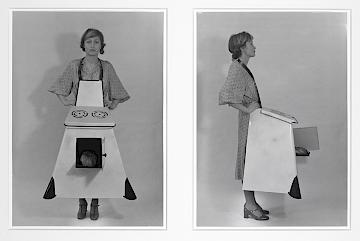re.act.feminism #2
In a video documenting Maja Bajevic’s performance Women at Work – Under Construction (Trilogy) (1999) – for which the artist invited five women refugees from Srebrenica to embroider onto the material stretched across scaffolding outside the National Gallery in Sarajevo – two passers-by can be heard discussing the work. Responding to a suggestion that the needlework will be ‘ripped off’ once the performance is completed, an elderly woman exclaims: ‘You mean they will destroy them? Why not display them as another work of art?’ Another voice replies: ‘Because then it is just embroidery […] and this is embroidery on scaffolding.’ It’s the value and agency of the traces left behind by performance which ‘re.act.feminism #2’ – a travelling archive of documentation of feminist performance works from the 1960s to the present – seeks to address.
In the Fundació Antoni Tàpies – the nomadic archive’s sixth host on its journey through Poland, Croatia, Denmark and Estonia before it reaches its final destination in Berlin – a wooden shipping container, fitted with shelves lined with DVDs and drawers filled with folders of photographs, stood ajar. There are many strategies for approaching this colossal content (Bajevic’s work is one of 180 documents); experimental way-finding is the archive’s most successful pedagogical proposition. mehr
Arbitrary selections produce unexpected conclusions: María Ruido’s La Voz Humana (The Human Voice, 1997), Antonia Baehr’s Lachen (Laughter, 2008) and Coco Fusco’s Operation Atropos (2006) together propose an analysis of the materiality of the voice as a constituent of gendered identity. Switching between works by the well-known proponents of feminist performance (Marina Abramovic´, Helena Almeida, Joan Jonas, Suzanne Lacy, Ana Mendieta, Adrian Piper and Martha Rosler) and those by artists whose practices have not necessarily been associated exclusively with this description (Oreet Ashery, Tania Bruguera, Lygia Clark, Esther Ferrer, Rose Finn-Kelcey and Kate Gilmore) allowed visitors to fragment the dominant narrative of where and when feminist performance art happened.
The geo-political map format, however, made it appear as though the selected works are part of a coherent art-historical movement with a North American and Western European centre, spilling out a little to the South and East. It’s significant that the ‘re.act.feminism’ project started with a 2009 exhibition in Berlin entitled ‘Performance Art of the 1960s and 1970s Today’, which included the work of 26 North American and European artists. It was one of a number of exhibitions and publications in the last decade that suggested a period of reflection on what is understood in North American scholarship as the second-wave era of feminist practices. In 2007 alone, the exhibition ‘WACK! Art and the Feminist Revolution’ was held at MOCA in Los Angeles; the Elizabeth A. Sackler Centre for Feminist Art at the Brooklyn Museum’s inaugural show was ‘Global Feminisms’; while Lacy and Leslie Labowitz’s travelling ‘Performing Archive’ documents women’s art produced between 1970–85. Of all the questions ‘re.act.feminism #2’ provokes but cannot answer – such as why does only one document refer to a performance by a male artist? If this is a ‘living’ archive why is there no record of the local research produced at each stop? – only one seems particularly urgent. If feminist performance is an international art-historical movement, how do we know what it looks like in distinct locations in which the popular and scholarly ‘return’ in the 2000s to ‘reflect’ on the ‘second wave’, has no currency?
In an essay entitled ‘How Do We Know What Latin American Conceptualism Looks Like?’ (2010), art historian Miguel A. Lopez examines Luis Camnitzer’s exhibition ‘Global Conceptualism: Points of Origin, 1950s–1980s’ (1999) at the Queens Museum of Art, positioning the Western art-historical category of ‘Conceptual art’ within a broader narrative of the trans-continental development of ‘Conceptualism’. Lopez warns that a side-effect of the well-intentioned commitment to ‘visibility’ (the project of ‘adding’ un-recognized happenings from ‘periphery’ sites of production) is the universalizing of a pre-configured category of identification. Lopez calls for a different way to create art history as surely by now ‘it is no longer a matter of tirelessly continuing to accommodate events in the endless container we believe history to be, but of questioning the ways in which they reappear’.
Although ‘re.act.feminism #2’ triumphs in the project of recuperation, its hybrid character – standing awkwardly between archive and exhibition – fails the project’s feminist intentions on two accounts. Its temporary status (due to copyright) means the archive is unable to secure the preservation of materials and therefore to be accountable for its own politics of inclusion and exclusion. Furthermore, the project lacks a curatorial strategy for supporting the assumed but un-declared identity of an international art-historical movement. Where history is experienced as both a metaphorical and literal (shipping) container, the potential ‘reactions’ are limited to the conservative mechanics of tireless addition. (ph1578)